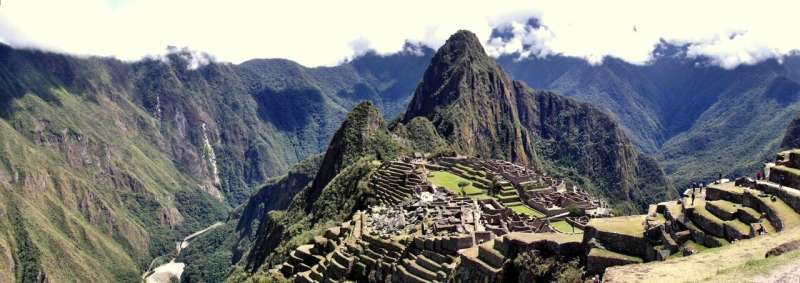This article has been reviewed according to Science X's editorial process and policies. Editors have highlighted the following attributes while ensuring the content's credibility:
fact-checked
peer-reviewed publication
trusted source
proofread
DNA analysis offers new insights into diverse community at Machu Picchu

A genetic analysis suggests that the servants and retainers who lived, worked, and died at Machu Picchu, the renowned 15th century Inca palace in southern Peru, were a diverse community representing many different ethnic groups from across the Inca empire.
The genomic data, described in a new study in Science Advances, is the first investigation of the genomic diversity of individuals buried at Machu Picchu and adjacent places around Cusco, the Inca capital. It builds upon previous archaeological and bio-archaeological research, including a 2021 Yale-led study which found that Machu Picchu (AD 1420-1530) is older than was previously believed.
"The DNA analysis not only confirms the historical accounts that retainers were drawn from many different ethnic groups under Inca control, but it also demonstrates a much greater diversity of origins than had been suspected with individuals being brought from the entire empire," said archaeologist Richard Burger, the Charles J. MacCurdy Professor of Anthropology in Yale's Faculty of Arts and Sciences and lead researcher for the Machu Picchu project.
"Our analyzes show that the population at Machu Picchu was highly heterogenous, with individuals exhibiting genetic ancestries associated with groups from regions throughout the Inca empire including the coast, highlands, and Amazonia," Burger said.
Researchers from Yale, Universidad Nacional de San Antonio Abad del Cusco (UNSAAC), the University of California-Santa Cruz (UCSC), Tulane University, the Max Planck Institute for Evolutionary Anthropology, and other institutions conducted the study, under an agreement to return artifacts and human remains from the Hiram Bingham collection back to Cusco for exhibition, conservation, and study.
Machu Picchu is perhaps the most famous archaeological site in the Western Hemisphere. Prior to the COVID-19 pandemic, more than a million visitors toured the site. Yet until quite recently, little was known about its inhabitants.
Scholars now believe Machu Picchu was a royal estate connected to the lineage of Pachacuti, the emperor credited with establishing the Inca empire. Royals resided at these estates seasonally, but a retinue of servants and retainers, known as yanacona, was left behind to take care of the facilities. Yanacona, who were brought to the estate from conquered lands, were believed to be privileged compared to the general population.
For the new study, researchers generated DNA data for 34 individuals buried at Machu Picchu who were believed to be retainers or attendants assigned to serve the Inca royal family, as well as 34 individuals from Cusco for comparative purposes.
"An unexpected result was the finding that many of the retainers were of Amazonian origin and about a third of them have DNA reflecting significant amounts of Amazonian ancestry," said lead author Lucy Salazar, a research associate in Yale's Department of Anthropology. "At least two zones within the Amazonian region are represented."
Another unexpected result, the researchers said, was that many of the individuals had mixed ancestries, often from regions distant from each other. The researchers said this suggests individuals at Machu Picchu were selecting mates from other genetic groups, producing a diverse population unlike those found in agricultural villages.
"This study does not focus on the life of 'royals' or political elites, but on the life of those that were brought to Machu Picchu to serve the nobility that lived there and operated the place," said co-corresponding author Lars Fehren-Schmitz, a professor at UC-SC and a former Yale post-doctoral researcher. "Thus, it gives us a unique insight into the life of a highly diverse community of individuals and their families who were subject to Inca forced relocation and resettlement policies, a group usually referred to as retainers or yanacona."
Co-corresponding author Jason Nesbitt, a former Yale Ph.D. student who is now an associate professor at Tulane, noted that few of the individuals buried at Machu Picchu were from the Inca heartland of the Cuzco Valley or the adjacent Lake Titicaca region. He also said the four cemetery areas at Machu Picchu were not organized by genomic origin. Even the individuals buried in a single burial cave represented diverse genomic backgrounds.
"These results suggest that Machu Picchu was a cosmopolitan community in which people of different backgrounds lived, mated, and were interred together," Burger said.
More information: Lucy Salazar et al, Insights into the Genetic Histories and Lifeways of Machu Picchu's Occupants, Science Advances (2023). DOI: 10.1126/sciadv.adg3377. www.science.org/doi/10.1126/sciadv.adg3377

















